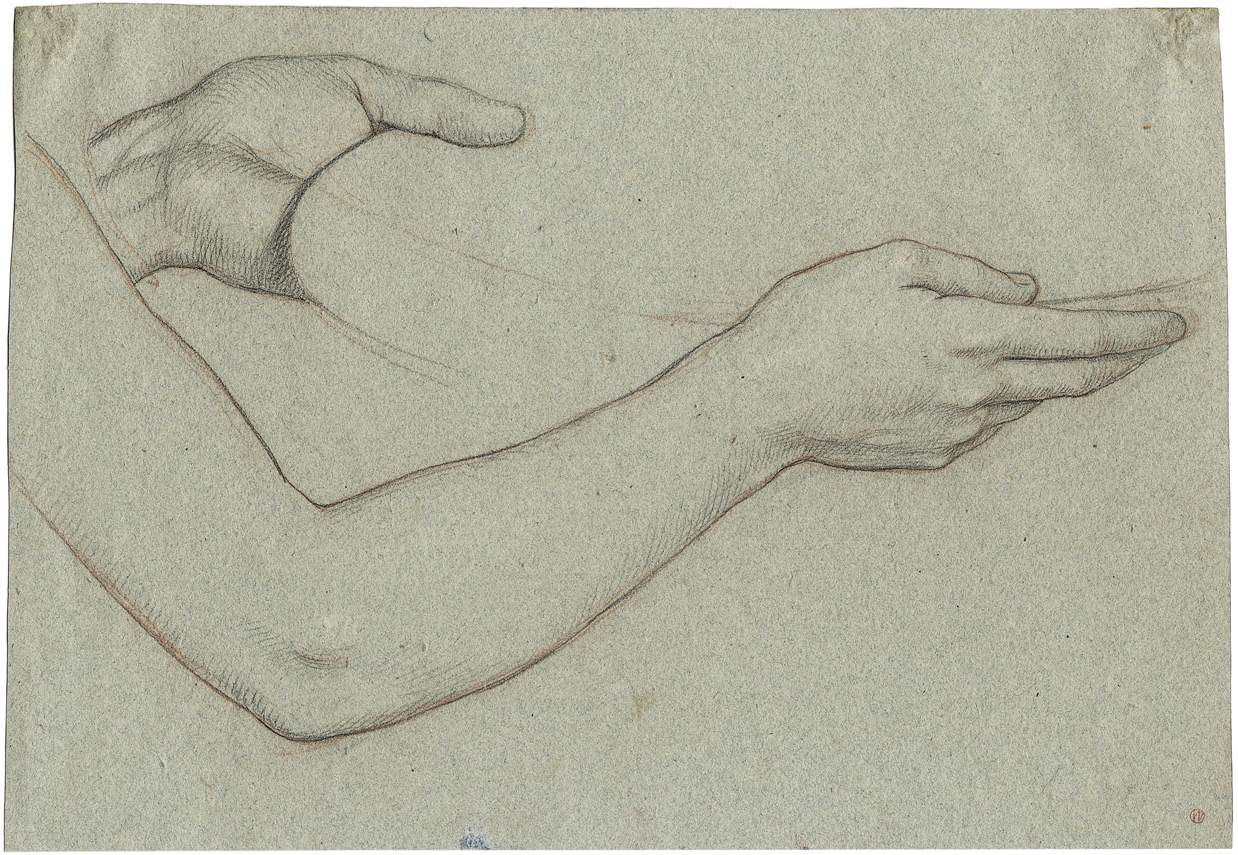Loading the page ...
Ludwig Ferdinand Schnorr von Carolsfeld
(1788 Königsberg – 1853 Vienna)
Study Sheet with Right Arm and Left Hand Holding a Bowl. Black and red chalk on grey-green paper. 21.3 x 31 cm. Circa 1839. Verso with estate stamp.
This study is a preliminary drawing for the monumental mural “The Feeding of the Five Thousand” (St. John 6, 1–15), which Schnorr von Carolsfeld executed in 1839 for the refectory of the Armenian Mechitarist Monastery in Vienna. Painted on canvas, the composition encompasses the whole width of the refectory (6 m) and follows the course of the vault above. What is shown is the first miracle of the loaves and fishes, as described in the four Gospels. Our drawing is preparatory for the small boy standing in the centre of the composition to the left of Jesus. The multi-figure, spatially complex composition not only depicts the miraculous occurrence itself, but also a number of subsequent events. The effect is that of a coherent dramatic production in which the beholder is able to participate emotionally in what is going on. The various emotions and gestures of the individual protagonists are well brought out. Although the fee was, as Schnorr von Carolsfeld put it, “meagre”, the commission constituted a succès d’estime for the artist. The painting belongs to the most important works of the Nazarene movement in Austria, ranking with the frescoes of the Casa Bartholdy in Rome and the Munich Residenz. In its purity of line and uncompromising sense of form this preliminary study reveals how much Schnorr von Carolsfeld owed to the artistic principles of the Nazarenes. Initially trained by his father, Hans Veit Friedrich Schnorr von Carolsfeld, Ludwig went on to study under Heinrich Füger at the Vienna Academy in 1804. Here he came into contact with the Catholic circles of Viennese Romanticism and was strongly influenced by the views of Friedrich von Schlegel. Starting in 1811, a fruitful association developed between the Schnorr von Carolsfeld brothers (Ludwig and Julius) and the Olivier brothers (Ferdinand and Friedrich). Their acquaintanceship with Joseph Anton Koch, who lived and worked in Vienna between 1812 and 1815, proved another significant stylistic influence. In 1818, after the death of Heinrich Füger, Ludwig applied unsuccessfully for a professorship at the Vienna Academy. That same year his brother Julius arrived in Rome, where he joined the Nazarenes. Ludwig’s later artistic career got off to an auspicious start. He was vigorously backed by his sponsor Archduke Johann, who employed him as a chamber painter in Styria from 1818 to 1828. At the instance of his mentor, Ludwig was made a member of the Vienna Academy in 1835 and appointed senior custodian of the Imperial collection of paintings at Schloss Belvedere in 1843. Nor was his work as a teacher without influence. Moritz von Schwind is held to be his most important pupil.
On the verso a study of a classical female head. From the Franz Winzinger Collection (Lugt 2600a, recto), verso with the estate stamp.
Contact us for further information